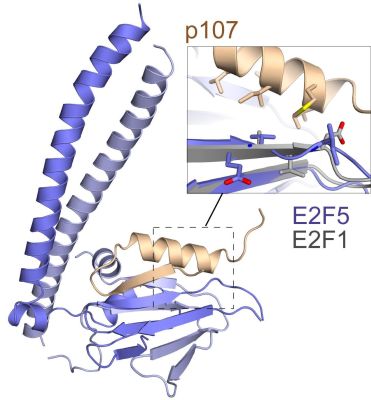 |
Figure: E2F5-DP1 transcription factor in complex with the retinoblastoma tumor suppressor, p107. |
Important cancer research came from Seth Rubin's laboratory at the University of California, Santa Cruz, who determined the crystal structure of the E2F5-DP1 transcription factor in complex with the inhibitor protein p107. E2F transcription factors drive cell proliferation during development and are activated in cancer. p107 is a member of the retinoblastoma (Rb) tumor suppressor protein family, which negatively regulates E2Fs to prevent cell division until the cell receives the proper growth signals. The crystal structure reveals how this inhibitory complex is assembled and the molecular details explaining why specific E2F and Rb family members preferentially associate. These results have important implications for understanding the tumor suppressor functions of Rb and p107 and ultimately for the design of new cell division inhibitors to treat cancer.
Citation: Liban TJ, Medina EM, Tripathi S, Sengupta S, Henry RW, Buchler NE, Rubin SM, Conservation and divergence of C-terminal domain structure in the retinoblastoma protein family, Proc. Natl. Acad. Sci. USA 114 (19), 4942-4947 (2017). DOI: 10.1073/pnas.1619170114